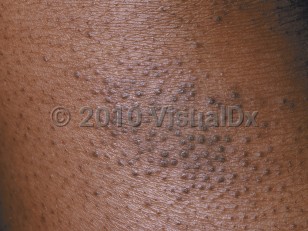Infants and children are most often affected, with 85% of cases appearing in the first year of life, and 95% of cases appearing by 5 years. Uncommonly, the condition may persist into, or even arise in, adulthood. Less than 1% of adults are affected by atopic dermatitis.
In infants, the disease involves primarily the face, scalp, torso, and extensor aspects of extremities. In children and adults, the disease usually involves chiefly the flexural aspects of extremities, but it may be more generalized. In adults, flexural skin may be clear, and disease may be focal or widespread. Follicular patterns of atopic dermatitis (ie, follicular eczema) are more common in persons with darker skin colors.
Atopic dermatitis may be categorized as follows:
- Acute – erythema, vesicles, bullae, weeping, crusting
- Subacute – scaly plaques, papules, round erosions, crusts
- Chronic eczema – lichenification, scaling, hyper- and hypopigmentation
Intense pruritus is a hallmark of atopic dermatitis. Scratching leads to lichenification (skin thickening). Impaired barrier function results in increased transepidermal water loss and susceptibility to secondary bacterial and viral infections. Patients with atopic dermatitis are prone to impetiginization with Staphylococcus aureus. Secondary infections with herpes simplex virus (eczema herpeticum), Coxsackie viruses (eczema coxsackium), vaccinia virus (eczema vaccinatum), or molluscum contagiosum may occur.
Patients with atopic dermatitis have difficulties in retaining skin moisture and suffer from xerosis (dry skin). Environmental triggers, such as heat, humidity, detergents / soaps, abrasive clothing, chemicals, smoke, and even stress, tend to aggravate the condition. Latex allergy and nickel allergy occur more often in persons with atopic dermatitis. Additionally, patients with atopic dermatitis have been found to be more likely to have positive patch test results to products commonly found in topical treatments, including cocamidopropyl betaine, wool alcohol / lanolin, and tixocortol pivalate. Allergy to eggs, cow's milk, or peanuts is common. There may be a relationship between atopic dermatitis and the development of aspirin-related respiratory disease.
Atopic dermatitis is increasing in the developed world. In the United States, about 10% of children may be affected by atopic dermatitis, but the majority of these cases are mild.



 Patient Information for
Patient Information for 
